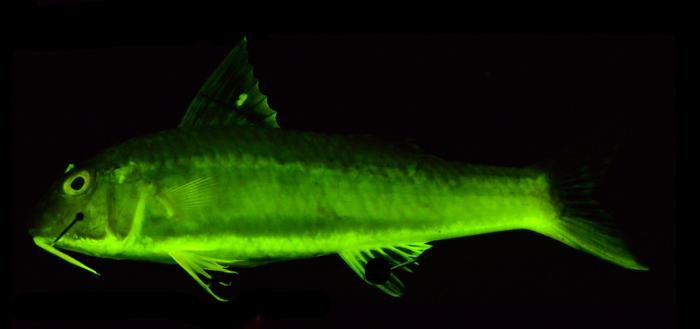New research led by scientists at the American Museum of Natural History has unveiled groundbreaking insights into the ancient evolutionary origins and remarkable diversity of biofluorescence in marine fishes. Published across two recent studies in leading journals, these findings push back the timeline of biofluorescence by over 100 million years, revealing a complexity and variety of fluorescent emissions far more expansive than previously recognized in the aquatic world. This work not only sheds light on the evolutionary pathways of this extraordinary biological adaptation but also hints at its potential ecological and functional roles within highly diverse marine ecosystems.
Biofluorescence, the phenomenon through which organisms absorb light at one wavelength and re-emit it at another, more vivid color, has been documented across various marine animals. Yet, its evolutionary roots and the precise breadth of its spectral emissions have remained elusive. The studies, conducted under the leadership of Emily Carr, a Ph.D. candidate at the Museum’s Richard Gilder Graduate School, employed cutting-edge phylogenetic analysis combined with sophisticated fluorescence imaging to map the historical emergence and diversification of biofluorescence in teleost fishes—bony fishes constituting the largest group of vertebrates alive today.
One of the landmark revelations is the independent evolution of biofluorescence over 100 times within marine teleost lineages. Data suggest these fluorescent traits first appeared approximately 112 million years ago, with eels representing some of the earliest instances. This extensive convergence underscores the adaptive significance of biofluorescence, particularly in the complex visual environments such as coral reefs, where the majority of biofluorescent fish species are found. Coral reef habitats, rich in both biodiversity and intricate light environments, appear to have acted as evolutionary crucibles driving the proliferation and diversification of fluorescence in marine fish.
The emergence of biofluorescence also parallels significant paleontological events, notably the Cretaceous-Paleogene (K-Pg) extinction around 66 million years ago, which saw the demise of all non-avian dinosaurs. Following this mass extinction, the rise of modern coral-dominated reefs provided new ecological niches that fostered rapid evolutionary radiation among reef-associated teleosts. Biofluorescence seems to have tracked this diversification closely, evolving at approximately ten times the rate in reef-dwelling fishes compared to their non-reef counterparts. This pattern suggests a strong ecological and perhaps behavioral linkage between fluorescence and reef environments.
The second study delved into the fine-scale characterization of fluorescence emission spectra across a variety of teleost families. Utilizing a novel photographic setup with ultraviolet (UV) and blue excitation light sources combined with emission filters, researchers examined specimens collected from diverse biogeographic regions including the Solomon Islands, Greenland, and Thailand. This methodological approach uncovered an extraordinary range of fluorescent emissions, spanning multiple wavelengths in the green, yellow, orange, and red spectra. Remarkably, some fish families exhibited at least six distinct fluorescent peaks, indicating highly complex and varied fluorescent pigmentation.
The phenotypic variability revealed raises compelling questions about the functional roles of biofluorescence. The researchers speculate that species-specific fluorescent emission patterns could serve as intricate signaling systems employed in camouflage, mate attraction, species recognition, or predation tactics. Such signaling mechanisms would be particularly advantageous in coral reef environments, where visual communication is pivotal amidst the vibrant and dynamic backdrop of reef habitats. Understanding the ecological significance of these fluorescent displays could transform our comprehension of sensory biology and communication in marine organisms.
In addition to ecological implications, the expanded diversity of fluorescent molecules discovered could have profound biomedical and biotechnological applications. Fluorescent proteins and molecules are invaluable in medical diagnostics, fluorescence-guided surgery, and cellular imaging due to their ability to emit light under controlled illumination. The discovery of novel biofluorescent molecules within teleost fishes opens potential avenues for the development of new fluorescent markers with unique spectral properties, possibly enhancing imaging clarity and specificity in clinical and research settings.
The collaboration on these studies spanned multiple institutions and disciplines, combining expertise in ichthyology, molecular phylogenetics, marine biology, and imaging technology. Among the co-authors are Rene Martin, Mason Thurman, Karly Cohen, Jonathan Huie, David Gruber, and Tate Sparks, all contributing to a comprehensive understanding of biofluorescence biology. The support for this research came from a range of sources including the National Science Foundation, Dalio Foundation, Stavros Niarchos Foundation, and institutional grants from the American Museum of Natural History.
Beyond the scientific discoveries, this research embodies the importance of long-term specimen collection, sophisticated imaging technology, and integrative phylogenetic approaches in uncovering evolutionary history and biodiversity. The specimens analyzed, many collected over the past fifteen years, illustrate the value of museum archives in enabling modern scientific breakthroughs. Such collections provide an irreplaceable resource for examining traits like biofluorescence that can only be understood in the context of broad comparative and temporal analyses.
As biofluorescence continues to intrigue scientists, this body of work sets a foundation for future research aimed at deciphering the molecular basis of fluorescence, its ecological and behavioral functions, and its evolutionary drivers across marine taxa. It challenges researchers to explore not just the visible expressions of biofluorescence but its underlying genetics and biochemistry, fostering interdisciplinary studies that integrate ecology, evolution, and molecular biology.
In conclusion, the elucidation of biofluorescence’s ancient origins and the identification of its extraordinary color diversity revolutionize our understanding of this captivating biological phenomenon. It underscores the adaptive ingenuity of marine fishes and highlights coral reefs as epicenters of evolutionary innovation. These insights broaden the horizon for new scientific inquiries into marine biodiversity, sensory biology, and the translational potential of biofluorescence in medicine and technology. The research spearheaded by Emily Carr and colleagues exemplifies how combining phylogenetics with advanced imaging can unlock nature’s luminous secrets and inspire future exploration of life’s hidden colors.
Subject of Research: Evolutionary origins and color diversity of biofluorescence in marine teleost fishes.
Article Title: Not explicitly stated in the provided content.
News Publication Date: Not specified.
Web References:
- Nature Communications study: https://www.nature.com/articles/s41467-025-59843-7
- PLOS One study: https://doi.org/10.1371/journal.pone.0316789
References:
- Nature Communications DOI: 10.1038/s41467-025-59843-7
- PLOS One DOI: 10.1371/journal.pone.0316789
Image Credits: © John Sparks and David Gruber
Keywords: Fish, Animal science, Marine biology, Ichthyology, Natural history




